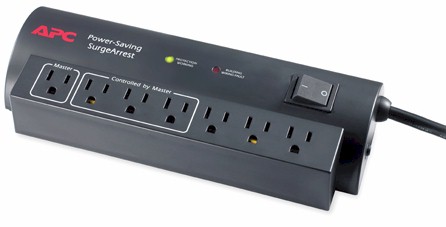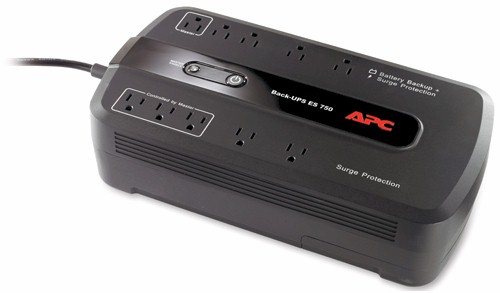I have been trying to do my part to reduce, recycle and reuse in my personal life. My household recycles as much as possible and our veggie garden and compost pile are doing nicely. And in the SmallNetBuilder lab, I have always powered down my computers at night, since I’m not that impatient to start work each morning.
But lately I have been feeling guilty about all the little LEDs that are still quietly blinking when I close my office door each night, as well as the power that continues to be sipped by the "off" multiple desktops and dual monitors.
So I recently decided to try to reduce the amount of "phantom" power used by the many electronic devices around the SmallNetBuilder manse. And it turns out that American Power Conversion (APC) had three things that were able to help me with my quest.
I forget where I first saw it, but APC’s P7GT Power-Saving Essential SurgeArrest turned on a light bulb (compact fluorescent, of course!) over my head. It’s a surge protecting power strip that has outlets that turn on and off controlled by the power draw from equipment plugged into a "Master" outlet.

Figure 1: APC Power-Saving Essential SurgeArrest (P7GT)
It took some digging to find on APC’s site, but after I finally figured out that the P7GT was the model to get, it wasn’t long before I ordered one up. The one page User Guide was a bit confusing in that it said that the computer plugged into the Master outlet had to be configured to go into Standby or Hibernation mode in order to have the Master outlet control work properly.
But I forged boldly ahead and actually shut my computer OFF and the Master-controlled outlets worked just fine. A second note in the User Guide revealed that the Master outlet trigger point is 15 Watts; above that will turn the controlled outlets on, below that, they’ll be off. This info isn’t included in the P7GT’s online spec page and there is no +/-% spec. So treat the 15 W as an approximate value.
So I plugged my APC BE500R Back-UPS ES into one of the P7GT’s controlled outlets. I also took the opportunity to consolidate all my lab gear so that it was running off the BE500R instead of it and an aging BK300C Back-UPS 300. But after a couple of abrupt power shutdowns, I took out my wattmeter and actually measured the load and found that I was asking too much of the BE500R.
It was then that I remembered an ad for APC’s Trade-UPS program, which lets you trade in your old UPS (any brand) for a new APC UPS with a full 2 year warranty at up to a 35% discount. The nice part is that APC provides pre-paid UPS return shipping labels, so APC takes care of the recycling!
You actually get to trade up for two times the wattage of the products that you trade in. So I was able to trade up to higher capacity products than the ones that I returned and got two BE750G Back-UPS ES750‘s for the BK300C and BE500R.

Figure 2: APC Back-UPS ES750 (BE750G)
I checked the BE750G $83 price from APC against Pricegrabber and found that I could have saved $30 if I had ordered two from another vendor. But having to not worry about paying for properly recycling the old APC’s (or return shipping to APC) sealed the deal for me.
The BE750G provided both the additional power capacity that I needed and incorporated the Master Controlled outlet feature of the P7GT power strip. So I was able to move the P7GT over to my wife’s system to automatically control her monitor and printer’s power.
Note that the BE750G’s Master Outlet actually has three programmable threshold settings: Low – 10 W; Medium (default) – 25 W; and High – 60 W. It also has coax and DSL-compatible phone line surge protection.
By the way, the second BE750G went into service in my living room to handle my plasma and its growing cadre of AV peripherals (DirecTV HD DVR, Slingbox, Roku Netflix, etc.). So now when I shut off the TV, most of the other gear (not the DVR) shuts off. The bright green power indicator on the BE750G, however, makes for quite a bright night light!
So now when I shut down the office for the night, everything (except for the the one "Master" computer that is still "sipping" power) is off. And while I know that my power savings won’t stop the polar icecaps from melting, maybe it will inspire others to eliminate even more wasted power.
